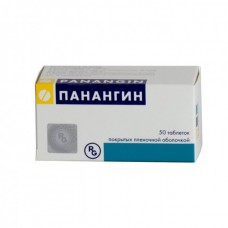Expiration date: 02/2025
The composition and form of issue:
The intravenous solution. 1 ampoule contains:
asparaginat potassium 452 mg
(corresponding to 103, 3 mg of potassium ions)
magnesium asparaginat 400 mg
(33 matches, 7 mg magnesium ions)
excipients: water for injections
in glass vials of 10 ml, in a contour plastic package 5 ampoules, in a cardboard pack 1 pack.
Tablets, film-coated. 1 tablet contains:
magnesium asparaginat 140 mg
(in the form of magnesium asparaginata · 4H2O — 175 mg)
asparaginat potassium 158 mg
(in the form of potassium asparaginata · 1/2H2O — 166, 3 mg)
excipients: silica colloidal anhydrous povidone magnesium stearate talc starch corn starch potato in the nucleus tablets
shell composition: macrogol 6000 titanium dioxide (color. ind. 77891, E171) methacrylic acid copolymer E100 % talc
in vials polypropylene, 50 PCs. in cardboard pack 1 bottle.
Description pharmaceutical form:
Solution: colorless or slightly green, clear solution without visible mechanical inclusions.
Tablet: round biconvex tablets, film-coated, white or almost white, slightly shiny and rough surface, almost odorless.
Pharmacokinetics:
Pills
Absorption is high. Excreted by the kidneys.
Description pharmacological action:
Solution
Panangin is a source of important electrolytes: potassium and magnesium ions. One of the most important functions of potassium is to maintain the membrane potential of neurons and of myocytes of excitable tissue structures of the myocardium. Disruption of the balance between intracellular and extracellular potassium leads to a decrease in cardiac contractility, arrhythmia, tachycardia and increase of toxicity of digitalis.
Magnesium is an important cofactor in more than 300 enzymatic reactions including energy metabolism and synthesis of proteins and nucleic acids. In addition, magnesium plays an important role in the work of the heart: reduces the strain of contraction and heart rate, leading to a reduction in the need of myocardium in oxygen. Reduced contractility of the myocytes of the smooth muscle of arterioles leading to vasodilation, including coronary vessels and increasing coronary blood flow. Magnesium has anti-ischemic effect on myocardial tissue.
The combination of potassium and magnesium ions in a single drug based on the fact that the deficit of potassium in the body is often accompanied by magnesium deficiency and requires the simultaneous correction of the levels of both ions further, while correction of the levels of these electrolytes, there is an additive effect (low levels of potassium and/or magnesium is proaritmogennym effect), in addition, potassium and magnesium to reduce toxicity of cardiac glycosides without affecting the positive inotropic effect of the latter.
Pills
The most important intracellular cations are K+ and Mg++ play a key role in the functioning of numerous enzymes in the formation of bonds between the macromolecules and cellular structures and in the mechanism of muscle contractility. Intra - and extracellular ratio of potassium ions, calcium, sodium and magnesium affects myocardial contractility. Exogenous aspartate acts as a conductor of ions has a high affinity to the cells, due to the insignificant dissociation of its salts, ions in the form of complex compounds penetrate inside the cell. Aspartate magnesium and potassium improve the metabolism of the myocardium. The lack of magnesium/potassium predisposes to the development of hypertension, atherosclerosis of the coronary arteries, arrhythmias and metabolic changes in the myocardium.
Indications:
Solution
- chronic heart disease (heart failure, state after myocardial infarction)
- heart rhythm disorders, primarily ventricular arrhythmias (as additional funds)
- therapy cardiac glycosides (as additional funds).
Pills
In an additional means:
- chronic heart disease (heart failure, state after myocardial infarction)
- cardiac arrhythmias (primarily ventricular arrhythmias)
- treatment of cardiac glycosides
- replacement therapy if lack of magnesium/potassium in food.
Contraindications:
Solution
- hypersensitivity to the drug
- acute and chronic renal failure
- Addison's disease
- AV blockade II and III degree
- cardiogenic shock (BP <90 mm Hg. article)
- hyperkalemia
- hypermagnesemia.
Be wary, AV blockade of 1 degree.
Pills
- hypersensitivity to any components of the drug
- acute and chronic renal failure
- hyperkalemia
- hypermagnesemia
- Addison's disease
- AV blockade of I–III degree
- cardiogenic shock (BP <90 mm Hg. article)
- the metabolism of amino acids
- myasthenia gravis
- hemolysis
- acute metabolic acidosis
- dehydration.
With caution:
- pregnancy (especially I trimester)
- the period of breastfeeding.
Application of pregnancy and breast-feeding:
Solution
Data on the adverse effects of the drug during pregnancy and breastfeeding are not available.
Pills
Be wary of pregnancy (especially I trimester) and breastfeeding.
Side effects:
Solution
With the rapid on/in the introduction may develop symptoms of hyperkalemia/gipermagniemii.
Pills
Possible nausea, vomiting, diarrhea, discomfort or burning in the pancreas (patients anatsidnyh gastritis or cholecystitis), AV blockade, paradoxical reaction (increased number of extrasystoles), hyperkalemia (nausea, vomiting, diarrhea, paresthesias), hypermagnesemia (redness of the face, thirst, decreased blood pressure, hyporeflexia, respiratory depression, seizures).
Drug interactions:
Solution
When administered in conjunction with potassium-sparing diuretics or ACE inhibitors may develop hyperkalemia.
Pills
Pharmacodynamic: concomitant use of potassium-sparing diuretics (triamterene, spironolactone), beta-blockers, cyclosporine, heparin, ACE inhibitors, NSAIDs increase the risk of hyperkalemia until the development of arrhythmias and asystole. The use of potassium supplements in conjunction with the GCS eliminates the hypokalemia caused the latter. Under the influence of potassium decreased adverse effects of cardiac glycosides. Batmotropnoe increases the negative effect of antiarrhythmic drugs. Anesthetics enhance inhibitory action of preparations of magnesium on the Central nervous system while the use of atracurium, decamethonium, succinylcholine and suxamethonium may increase neuromuscular blockade calcitriol increases the content of magnesium in blood plasma, calcium supplements reduce the effect of magnesium preparations.
Pharmacokinetic: binding and enveloping means reduce the absorption of the drug in the gastrointestinal tract and it is necessary to observe a three-hour interval between ingestion of Panangin with these funds.
Method of application and dose:
Solution
In/in the drip by slow drip infusion containing 10-20 ml of Panangin.
To prepare the solution for the on/in the introduction 1-2 contents of the amp. dissolve in 50-100 ml of 5% glucose solution.
If necessary, the introduction can be repeated after 4-6 hours
Perhaps the use of Panangin in combination therapy.
Pills
Inside, after eating, because the acidic environment of the stomach reduces its effectiveness.
Before applying you should consult with your doctor.
The usual daily dose — table 1-2. 3 times a day. The maximum daily dose — 3 table. 3 times a day.
The duration of drug intake and the need for repeated courses is determined by the physician.
Overdose:
Solution
Symptoms: hyperkalemia, hypermagnesemia.
Treatment: cancel the drug, symptomatic therapy (in/in the introduction of a 100 mg/min calcium chloride), if necessary — dialysis.
Pills
Symptoms: abnormal conduction (especially with previous pathology of the conduction system of the heart).
Treatment: in/with the introduction of calcium chloride, if necessary, — hemodialysis and peritoneal dialysis.
Special instructions:
You should exercise special care in case of diseases accompanied by hyperkalemia, it is recommended to monitor the levels of ions in blood.
Does not affect the ability to drive and engage in activities, require high concentration and psychomotor speed reactions.
Additionally, for a solution: with the rapid introduction may develop redness of the skin.
Panangin
(Potassium
aspartate
and
magnesium
aspartate)
- Brand: Gedeon Richter

- Availability:
in stock


